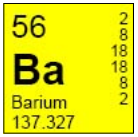Barium
View/Download PDF Version
Barium
- Barium is a silvery-white metallic element found abundantly in nature in limestone and sandstone. Barium is used in the manufacture of paint, paper, ceramics, glass, special cement, Xray diagnostic work, oil well drilling fluids, rubber, linoleum, and rat poison. Potential sources of contamination in drinking water include discharge of drilling wastes, discharge from metal refineries, and erosion of natural deposits.
- The USEPA has set a drinking water standard of 2.0 mg/L for barium in public drinking water supplies. These regulations do not apply to private water supplies but the health implications are the same for private well owners.
- The lethal dose of barium is approximately 550 mg. It would take over 7 gallons of barium contaminated water at 10 times the EPA standard to kill someone immediately. The more likely type of health effect from barium comes from low dosages over a long period of time or “chronic” effects. Increased blood pressure is the primary health effect from barium.
- Treatment of water for barium can be accomplished with ion exchange, reverse osmosis, or distillation.
Additional Resources
Click on the links below to be directed to more resources.
US EPA National Primary Drinking Water Regulations
Water Quality Interpretation Tool
Handbook of Drinking Water Quality; John DeZuane; 1997
